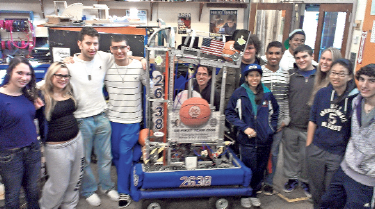The robot, about six feet tall and scrambling laterally across the shop floor, has one main function: to dunk basketballs.
It’s the work of the Great Neck South High School robotics team, which designed and built the machine before guiding it to an award-winning finish at last year’s School-Business Partnerships of Long Island regional robotics competition.
The team, which is entering its sixth year, is both a class and an after-school club overseen by advisor John Motchkavitz.
And for the students who put class time and, sometimes, long nights towards the team’s project, it can be an powerful experience.
“It’s more than an after-school club,” said senior David Erlich, who has participated in the robotics club since his freshman year. “It’s like a family.”
Robotics is a full-year class, said Motchkavitz, that teaches students the history of robotic engineering.
But it’s the practical and competitive elements of the club that make it different from other science offerings at Great Neck South.
“It’s all based on teamwork and problem solving and coming up with a solution,” Motchkavitz said.
The team participates in the USFirst Robotics competition, which was founded by Segway inventor and Long Island native Dean Kamen and attracted 2,500 high school teams last year.
Last spring, the team won their regional competition’s Engineering Inspiration award, which guaranteed them a $5,000 grant and a trip to the world championships in St. Louis, Mo.
The competition schedule is demanding. Teams are given six weeks to design and build a robot to accomplish a task set by competition organizers.
This year, that meant shooting basketballs.
Footage of last year’s competition shows color-coded teams of robots racing around an inclosed arena, with Great Neck South’s lanky machine eventually succeeding in balancing on a see-saw.
The first moments after the competition’s challenges are announced are both hectic and exciting, said sophomore Hayley Strongin.
“Everyone’s minds are running,” she said. “Everyone is saying what they want to do.”
After the initial rush, the work begins. Students handle virtually every aspect of the project, from design and construction to creating a business plan and enforcing safety standards.
It’s a significant time commitment, but one worth making, according to Erlich, Strongin, and fellow team member David Dressner.
Erlich, who said his parents understood his level of dedication to the program, described rushing from his sister’s bat mitzvah reception to the competition and back again
“It’s a lot of long nights the kids are working on it,” Motchkavitz said.
Erlich and Dressner, a senior, both said they want to pursue engineering in college.
For Dressner, the hands-on nature of the club is a major part of its appeal.
“In math class it becomes really abstract… in robotics, it’s really clear,” he said. “You’re making a robot. You can use this.”
Motchkavitz said that he takes pride in the efforts and creativity of his students, who build the robot largely without instruction.
“You always want your students to be better than you,” he said. “If they’re better than [their teachers,] we’ve done our job.”
Motchkavitz said the team was expanding its ambitions this year.
“We’ve done a lot of fundraising, and we’re going to a second regional,” he said.



